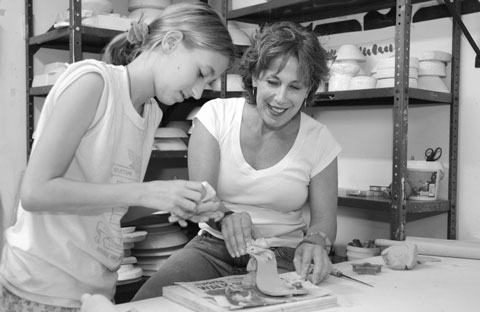By Linda Riddle
A motley gang of hedgehogs, reptiles and pigs stares out from its perch. The creatures’ rainbow skins — icy blue, lemon yellow, petal pink — glisten in the sunlight. The menagerie of fantastical clay animal sculptures is the creative handiwork of students at Tribeca Clayworks, 19 Hudson St.
Owner Susan Kay, a longtime Tribeca resident, teaches children how to work with clay in her upper floor studio. Students from ages 3 to 16 create both fanciful and functional sculptures.
Trained in ceramics and sculpture at Brooklyn’s Pratt Institute, Kay, 51, started her clay classes serendipitously. She first began teaching aerobics classes in the neighborhood back in the 1980’s as an outgrowth of her interest in modern dance. But ceramics and sculpture were also a life-long interest so she began displaying her pieces in the aerobics studio.
After she gave birth to her daughter Morgan, now 16, her interest in the growth and development of children heightened. So in 1993, when one of her aerobics students asked her to teach clay works to her 7-year-old daughter, she jumped at the chance. It was the beginning of Tribeca Clayworks.
Today, Kay maintains a 500-square-foot studio dedicated to ceramics. Kay capitalizes on children’s natural interest in working with their hands, introducing them to the basics of fashioning clay into objects.
“Kids work with their hands from a very early age,” says Kay. “It’s the first thing they work with.”
With a ball of white clay in their hands, new students feel what happens when they manipulate it. Kay starts by teaching rudimentary hand-building techniques of pinching clay into pot shapes and rolling it into long coils to form other shapes. From this basic exercise, her students begin to understand the material they are working with.
“They get to feel what happens if they squeeze hard, if they don’t squeeze hard enough, what a finger does,” says Kay. “I try to mix these skills with some kind of idea, something that is exciting to them.”
So a ball of clay evolves into a simple bowl and then into an animal.
Elizabeth Cote, 10, a student at Clinton School for Artists and Writers in Chelsea, began after-school clay classes two years ago. “I enjoy the freedom of being able to choose what to make,” says Cote. “The kids are very social. It’s fun to be with them.”
Cote has learned how to use a pottery wheel and has made bowls, a piggy bank, spice shakers and birthday plaques for friends. Her work has been displayed at a neighborhood church art exhibit.
Another student, Jenni Sussell, 16, started studying ceramics eight years ago and now assists Kay with some of her classes, handing out materials and helping with other classroom tasks.
“It was a really good thing to do after school,” says Sussell, a student at LaGuardia School of Performing Arts. “I got to sit and relax with friends.”
Kay introduces everyday objects such as heart-shaped candy boxes, game boards and plastic mats to inspire students to think about the shapes and patterns of their pieces. Brandishing a garlic press, Kay says she looks for inspiration everywhere.
“I like to push the scale and get students to work on bigger pieces, to experiment,” she said.
She also looks for opportunities to showcase her students’ work and has persuaded some Tribeca merchants, such as Shoefly, a children’s shoe store, to display ceramics in their store windows.
“It was a nice way for the kids to walk by and see their work in the window,” said Roz Viemeister, manager of Shoefly. “It’s a fun thing.”
Kay’s classes are organized by age group, starting with 3 and 4-year-olds. Each class accommodates up to 12 students.
Seeing her students progress and discover something that they can create, and building their confidence, is Kay’s deepest satisfaction.
“You want these kids to be successful — to walk out feeling like they can do it,” she said. “I enjoy their company. They’re my kids.”


















